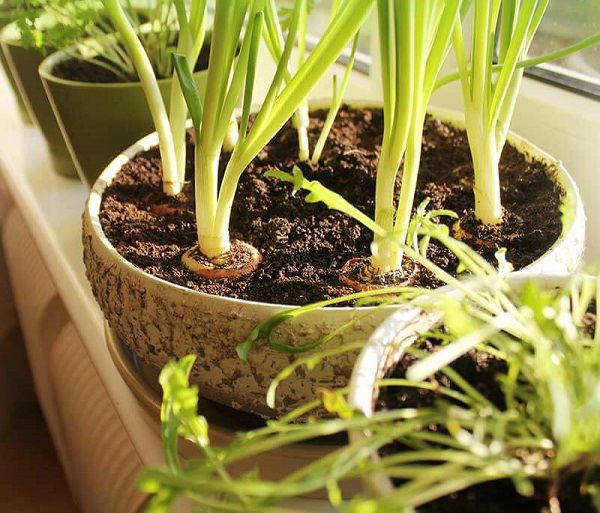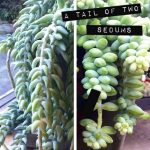Allium is the name of a great genus of plants for container gardeners. “Allium” literally means “garlic” in Latin, but botanically speaking, it includes onions, chives, and ornamental flowers as well. They all grow from bulbs, and all have grass-like or tubular leaves with an onion/garlic scent to them when you brush up against the leaves. Because of their bulbous nature, they tend to be able to survive a bit of neglect, great for beginners and lazy gardeners!
Here’s how to grow several different types of edible alliums on your patio, porch, balcony, rooftop, or anywhere else you can stick a pot.
Chives
I find chives annoying to start from seed (they seem to take a while to germinate, and will only germinate if the conditions are perfectly acceptable to their delicate sensibilities), so I always use plants bought from the nursery. Since they are perennial, if you buy chives once, you pretty much have them for life. Even in cold climates where hard freezes will kill the leaves, the plant should come back in spring.
The plants themselves are very easy to care for. If you’re growing them in a pot by themselves, choose one that is a few inches taller and wider than the pot the plants were growing in at the nursery (a minimum of 8 inches tall and wide). They also make a great “filler plant” in larger, mixed containers.
Chives are happiest being watered whenever the soil dries out, but I have inadvertently forgotten to water my plants for weeks, and they perked up and were just fine when I gave them a drink. If you use chives regularly in your cooking, fertilize your plants once a month. If you don’t use them too often, every other month is fine.
Varieties to look for: The options are rather limited, you’ve got chives and garlic chives (flat leaves, white flowers, faint garlic taste).
Scallions
Scallions are usually just immature onions, though there is such a thing as a “bunching onion” which never develop a fat, onion bulb and are always eaten as a scallion. Growing scallions, bunching onions, and actual onions are all pretty much the same.
Scallions are easy to start from seed. You can start them inside about a month before your last frost and sow more seeds every several weeks for a staggered harvest. As the seedlings grow, if you mostly want the white part of the scallion (both parts are edible), mound up more soil around the base as the plant grows. This will blanch the base and force it to be white.
When your plants are ready to transplant outside, I’ve found windowbox shaped pots to be ideal. Scallions can be grown very close together (about two inches apart), so you can fit several rows of plants in a typical window box. Or, if you prefer, arrange them in concentric circles in a round pot. Their roots are relatively shallow, so anything 8 inches deep or more is fine.
Varieties to look for: I’m growing ‘Delicious Duo’, they’re a nice mix between scallions with a white base and those with red-tinged bases. You can also grow heirloom variety called ‘Italian Red of Florence’ that has a slightly bulbous, very deep red base.
Garlic, Green Garlic & Garlic Scapes
Garlic is worth a try because you can grow more interesting varieties than what is easily available at the store. “Green garlic” sounds mysterious but it’s just the leaves of regular garlic, which you can cut off whenever you wish if you don’t plan on harvesting the bulbs below (it stresses the plant out too much for much of a garlic head to form). Garlic scapes are the flower stalks of hard-neck varieties of garlic. They’re edible and delicious!
If it’s heads of garlic you’re aiming for, I’ve had the best results in long window boxes or planter boxes. Don’t plant garlic you buy at the regular supermarket because it has probably been treated with a chemical to prevent it from sprouting. You’ll find the most interesting varieties from mail order catalogs/websites, but organic varieties at farmers markets will also work. Plant the cloves 4 inches deep and 4 inches apart in fall (October for temperate climates, November-January for mild-winter climates). Be sure to put down a balanced fertilizer at the time of planting. Don’t let the soil completely dry out, but other than that, ignore them until the leaves start popping up in spring.
Once leaves start popping up in spring, keep the soil evenly moist and fertilize once a month. Your plants should be ready to harvest in June or July. Soft-neck varieties tell you they’re ready by flopping over. Hard-neck varieties straighten their curled scapes.
If you’d like green garlic, simply pop a few cloves of an organic garlic bulb you bought at the farmers market and starting in early spring, stick the cloves in any container that has room for them. Keep them well watered (but not soggy) and fertilize with a balanced fertilizer once a month. Harvest the leaves whenever you need a mild garlic flavor in something you’re cooking, they will come back for several more harvests.
Varieties to look out for: Chesnok Red is the best all-around variety for cooking, while Spanish Roja is the favorite of garlic connoisseurs. Chinese Pink is an extra early soft-neck variety that you can start harvesting in May.
Onions
I don’t think onions are a good use of space on a container garden, they take a long time to grow, and homegrown onions taste exactly like store-bought varieties, but if you insist on growing your own, here’s a how to.








1 Comment
Silje Randrup
January 30, 2020